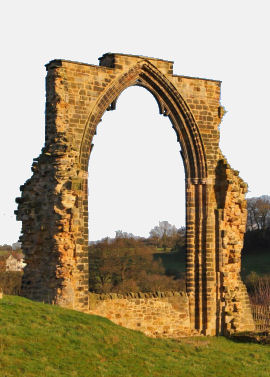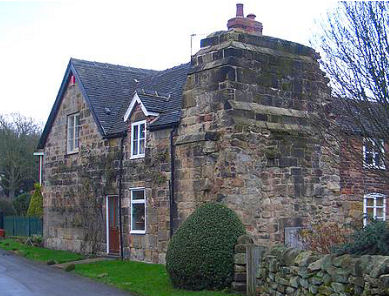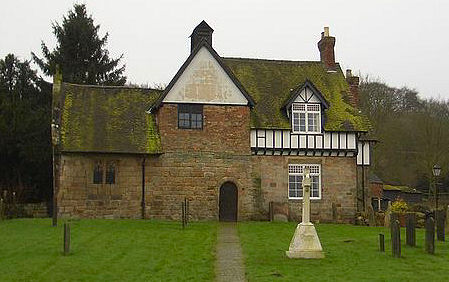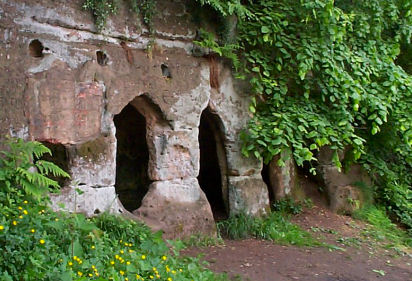Dale Abbey
OS grid ref:- SK 436 388
 The small Derbyshire village of Dale Abbey, a Conservation Area since 1972, lies 3 miles to the south west of Ilkeston and 6 miles north east of Derby. Known formerly as Depedale or Deepdale, the village contains the remains of a medieval abbey.
The small Derbyshire village of Dale Abbey, a Conservation Area since 1972, lies 3 miles to the south west of Ilkeston and 6 miles north east of Derby. Known formerly as Depedale or Deepdale, the village contains the remains of a medieval abbey.
Augustinian monks from Calke Abbey settled at Dale Abbey in 1162, a few years later they were joined by Premonstratensian canons from Tupholme and finally by a further group of monks from Welbeck. From around the year 1199, the Abbey became well established.
 The Abbey was disolved by King Henry VIII in 1539 bringing an end to almost four centuries of monastic life there. The abbey came into the possession of Sir Francis Pole of Radbourne. The furnishings and fittings were either gradually sold off or stripped out and installed in other churches.
The Abbey was disolved by King Henry VIII in 1539 bringing an end to almost four centuries of monastic life there. The abbey came into the possession of Sir Francis Pole of Radbourne. The furnishings and fittings were either gradually sold off or stripped out and installed in other churches.
Morley Church became home to some of the stained and painted glass, floor tiles and an entire porchway from the abbey. The ornately carved font cover was installed in Radbourne Church while Chaddesden received a window frame. The font eventually found its way back to All Saints Church Dale Abbey in 1884 and the slabs upon which the canons walked for so many centuries can be found in the grounds of the church at the Moravian Settlement at Ockbrook.
The remains consist of a large thirteenth century chancel window, (pictured above left) which stands at 40 feet high and originally contained geometric tracery. There are also remnants of walls and pillars and the remains of the gatehouse to the rear of the Gateway Centre. Excavations have revealed the church to have possessed transepts of over 100 feet in length, a crossing tower, a cloister which measured 85 feet square and a nave of unknown length. Some of the remains of the building can be found in some of the houses around the village. To the east of the abbey window are earth banks which dammed the Sow Brook to make a monastic fish pond.
 Abbey House and Manor House, a pair of medieval cottages incorporate remains (possibly the kitchen) of the Abbey, medieval outbuildings behind the Methodist church were probably its gatehouse.
Abbey House and Manor House, a pair of medieval cottages incorporate remains (possibly the kitchen) of the Abbey, medieval outbuildings behind the Methodist church were probably its gatehouse.
The tiny village church of All Saint's, (pictured left) measuring just 26 by 25 feet, is probably one of the smallest in the country and shares a roof with an adjoining farmhouse. Dating from the mid twelfth century, the building was altered in 1480. It contains a pulpit dating from 1634.
The adjoining farmhouse may have been used as an infirmary for the Abbey. For some time before 1820 it was used as a pub called the Blue Bell, the bar being used as a vestry, with a door into the aisle. It was rebuilt in 1883. '...it is said the village inn was anciently under the same roof, and there was a door in the wall leading from the gallery into the house, through which the worshippers were accustomed to steal to refresh themselves.''The clergyman used to dress in the bar of the Blue Bell inn and enter the church through a now-blocked door'. Across the road from the church are the remains of a monastic pond.
 Behind the church is an area of woodland which contains Hermit Cave, a scheduled ancient monument, which was hewn out of the sandstone cliff by a twelfth-century Derby baker who wished to live a life as a recluse devoted to solitude and prayer, after reporting the Virgin Mary came to him in a dream instructing him to do so. The cave measures 6 yards by 3 with a doorway, two windows, a peephole and a niche for a light.
Behind the church is an area of woodland which contains Hermit Cave, a scheduled ancient monument, which was hewn out of the sandstone cliff by a twelfth-century Derby baker who wished to live a life as a recluse devoted to solitude and prayer, after reporting the Virgin Mary came to him in a dream instructing him to do so. The cave measures 6 yards by 3 with a doorway, two windows, a peephole and a niche for a light.
Local legend relates that when Ralph Fitz-Geremund, a Norman knight and the owner of Depedale as it was then known, while hunting in the surrounding woods, noticed the smoke from the hermit's fire and discovered him. Touched with pity for his poverty, Fitz-Geremund gave him not only the site of the hermitage but a tithe of a mill at nearby Borrowash.
There the hermit built himself a more pretentious oratory and a cottage to end his days, which occupied the site of the present village church.
The Cat and Fiddle windmill, which dates from the eighteenth century, is the only one left of its kind in Derbyshire.
The village pub, the Carpenters Arms, provides meals and fine ales. The building dates back in part to the late 1600s
Nearby places of interest
Derby Cathedral- the smallest Anglican Cathedral in England and was founded by the Saxon King Edmund I (922 –946).
